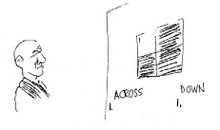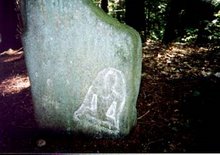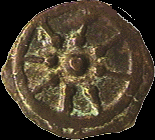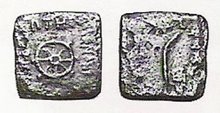
The Ten Ox Herding Pictures
From
The Manual of Zen Buddhism,
By
Shubun (15th Century). With adjustments to the D.T. Suzuki translation.

1. Undisciplined
With his horns fiercely projected in the air, the beast snorts. Madly running over mountain paths, farther and farther he goes astray! A dark cloud spreads across the entrance of the valley. And who knows how many of the fine fresh herbs he has trampled carelessly under his wild hoofs?

2. Discipline Begun
Now in possession of a straw rope, I pass it through his nose. Once he makes a frantic attempt to run away, but he is severely whipped. The beast resists training with all the power he has in his wild and ungoverned nature. But the rustic ox herder maintains a steady pull on the tether and is ever-ready to correct with his whip.

3. In the Harness
Gradually, after getting into the harness, the beast is now content to be led by the nose. Crossing a stream or walking along a mountain path, he follows every step of the leader; The leader holds the rope firmly in his hand never letting it go,
All day long he is on the alert - almost unconscious of fatigue.

4. Faced Around
After many long days of training the result begins to show and the beast's faced is turned; A nature once so wild and ungoverned is finally broken, he has become gentler; But the tender has not yet given him his full confidence, He still maintains his straw rope with which the ox is now tied to a tree.
 Face turned after long days of training... A nature once wild becomes governed...
Face turned after long days of training... A nature once wild becomes governed...

5. Tamed
Under the green willow tree and by the ancient mountain stream, The ox is set at liberty to pursue his own pleasures; At the eventide when a grey mist descends on the pasture, The boy winds his homeward way with the animal quietly following.

6. Unimpeded
On the verdant field the beast contentedly lies idling his time away, No whip is needed now, nor any kind of restraint; The boy too sits leisurely under the pine tree, Playing a tune of peace, overflowing with joy.

7. Laissez Faire
The spring stream in the evening sun flows languidly along the willow-lined bank,
In the hazy atmosphere the meadow grass is seen growing thick; When hungry he grazes, when thirsty he quaffs, as time sweetly slides, While the boy on the rock dozes for hours not noticing anything that goes on about him.

8. All Forgotten
The beast is all in white now and surrounded by the white clouds, The man is perfectly at his ease and care-free, so is his companion; The white clouds penetrated by the moon-light cast their white shadows below, The white clouds and the bright moon-light-each following its course of movement.

9. The Solitary Moon
Nowhere is the beast, and the oxherd is master of his time, He is a solitary cloud wafting lightly along the mountain peaks; Clapping his hands he sings joyfully in the moon-light; But remember, a last wall is still left barring his homeward walk.

10. Both Vanished
Both the man and the animal have disappeared, no traces are left, The bright moon-light is empty and shadowless with all the ten-thousand objects in it;
If anyone should ask the meaning of this, Behold the lilies of the field and its fresh sweet-scented verdure.


Both Zen Circles allude to the moon in picture 10 above.
But
the message, I was told, was not in the pictures, but
in the intervals between the pictures.
The intervals?
I was, for 50 years, puzzled by this statement.
The interval?
The interval?
The interval?
The interval?
The interval?
Bardo!
Bardo!
It is Bardo!
So now I see each picture as a separate and distinct incarnation of the monk on his path through the many cycles of birth-death. With each turning of the wheel he makes incremental progress toward nirbana - with small but significant gains to show for each incarnation.
And, in the due course of time, he achieves oneness with all as represented by picture 10 and the Zen Circle. There is no shadow in the 'moon' because it is not the moon that is represented - it is nirbana.
There is another detail worthy of notice - the big dipper in picture 9. The "be well" or Svasti (seen below) is symbolic of the
big dipper rotating in
the northern sky. This is an allegorical representation of the turning of the wheel of birth-death cycles.

Addendum:
I was asked, in an unpublished comment, how a Buddhist Text could have an Ox Herder
whipping an ox. That distinction between Ox Herder and Ox is purely artificial. The Ox
is the wild and ungovernable characteristic of the herder (the animal within the man). When the "ox" is completely tamed (the passions deemed governable), he is no more - as in picture 9. But there remains one more barrier - the sense of self - between the boy/man/monk and his 'home.' When that self has dissipated then nothing remains - except nirbana (the shadowless 'moon.') One could say that Zen is also: “A system of morality, veiled in secrecy, and illustrated by symbols.”

D.T. Suzuki
source
"Zen psychology: Daisetz Suzuki remembered
More than any other Eastern thinker in the 20th century, Suzuki catalyzed the rise of humanistic psychology, which has spurred today's interest in spirituality and well-being"
 The Ten Ox Herding Pictures
From The Manual of Zen Buddhism,
By Shubun (15th Century). With adjustments to the D.T. Suzuki translation.
The Ten Ox Herding Pictures
From The Manual of Zen Buddhism,
By Shubun (15th Century). With adjustments to the D.T. Suzuki translation.
 1. Undisciplined
With his horns fiercely projected in the air, the beast snorts. Madly running over mountain paths, farther and farther he goes astray! A dark cloud spreads across the entrance of the valley. And who knows how many of the fine fresh herbs he has trampled carelessly under his wild hoofs?
1. Undisciplined
With his horns fiercely projected in the air, the beast snorts. Madly running over mountain paths, farther and farther he goes astray! A dark cloud spreads across the entrance of the valley. And who knows how many of the fine fresh herbs he has trampled carelessly under his wild hoofs?
 2. Discipline Begun
Now in possession of a straw rope, I pass it through his nose. Once he makes a frantic attempt to run away, but he is severely whipped. The beast resists training with all the power he has in his wild and ungoverned nature. But the rustic ox herder maintains a steady pull on the tether and is ever-ready to correct with his whip.
2. Discipline Begun
Now in possession of a straw rope, I pass it through his nose. Once he makes a frantic attempt to run away, but he is severely whipped. The beast resists training with all the power he has in his wild and ungoverned nature. But the rustic ox herder maintains a steady pull on the tether and is ever-ready to correct with his whip.
 3. In the Harness
Gradually, after getting into the harness, the beast is now content to be led by the nose. Crossing a stream or walking along a mountain path, he follows every step of the leader; The leader holds the rope firmly in his hand never letting it go,
All day long he is on the alert - almost unconscious of fatigue.
3. In the Harness
Gradually, after getting into the harness, the beast is now content to be led by the nose. Crossing a stream or walking along a mountain path, he follows every step of the leader; The leader holds the rope firmly in his hand never letting it go,
All day long he is on the alert - almost unconscious of fatigue.
 4. Faced Around
After many long days of training the result begins to show and the beast's faced is turned; A nature once so wild and ungoverned is finally broken, he has become gentler; But the tender has not yet given him his full confidence, He still maintains his straw rope with which the ox is now tied to a tree.
4. Faced Around
After many long days of training the result begins to show and the beast's faced is turned; A nature once so wild and ungoverned is finally broken, he has become gentler; But the tender has not yet given him his full confidence, He still maintains his straw rope with which the ox is now tied to a tree.
 Face turned after long days of training... A nature once wild becomes governed...
Face turned after long days of training... A nature once wild becomes governed...
 5. Tamed
Under the green willow tree and by the ancient mountain stream, The ox is set at liberty to pursue his own pleasures; At the eventide when a grey mist descends on the pasture, The boy winds his homeward way with the animal quietly following.
5. Tamed
Under the green willow tree and by the ancient mountain stream, The ox is set at liberty to pursue his own pleasures; At the eventide when a grey mist descends on the pasture, The boy winds his homeward way with the animal quietly following.
 6. Unimpeded
On the verdant field the beast contentedly lies idling his time away, No whip is needed now, nor any kind of restraint; The boy too sits leisurely under the pine tree, Playing a tune of peace, overflowing with joy.
6. Unimpeded
On the verdant field the beast contentedly lies idling his time away, No whip is needed now, nor any kind of restraint; The boy too sits leisurely under the pine tree, Playing a tune of peace, overflowing with joy.
 7. Laissez Faire
The spring stream in the evening sun flows languidly along the willow-lined bank,
In the hazy atmosphere the meadow grass is seen growing thick; When hungry he grazes, when thirsty he quaffs, as time sweetly slides, While the boy on the rock dozes for hours not noticing anything that goes on about him.
7. Laissez Faire
The spring stream in the evening sun flows languidly along the willow-lined bank,
In the hazy atmosphere the meadow grass is seen growing thick; When hungry he grazes, when thirsty he quaffs, as time sweetly slides, While the boy on the rock dozes for hours not noticing anything that goes on about him.
 8. All Forgotten
The beast is all in white now and surrounded by the white clouds, The man is perfectly at his ease and care-free, so is his companion; The white clouds penetrated by the moon-light cast their white shadows below, The white clouds and the bright moon-light-each following its course of movement.
8. All Forgotten
The beast is all in white now and surrounded by the white clouds, The man is perfectly at his ease and care-free, so is his companion; The white clouds penetrated by the moon-light cast their white shadows below, The white clouds and the bright moon-light-each following its course of movement.
 9. The Solitary Moon
Nowhere is the beast, and the oxherd is master of his time, He is a solitary cloud wafting lightly along the mountain peaks; Clapping his hands he sings joyfully in the moon-light; But remember, a last wall is still left barring his homeward walk.
9. The Solitary Moon
Nowhere is the beast, and the oxherd is master of his time, He is a solitary cloud wafting lightly along the mountain peaks; Clapping his hands he sings joyfully in the moon-light; But remember, a last wall is still left barring his homeward walk.
 10. Both Vanished
Both the man and the animal have disappeared, no traces are left, The bright moon-light is empty and shadowless with all the ten-thousand objects in it;
If anyone should ask the meaning of this, Behold the lilies of the field and its fresh sweet-scented verdure.
10. Both Vanished
Both the man and the animal have disappeared, no traces are left, The bright moon-light is empty and shadowless with all the ten-thousand objects in it;
If anyone should ask the meaning of this, Behold the lilies of the field and its fresh sweet-scented verdure.

 Both Zen Circles allude to the moon in picture 10 above.
But the message, I was told, was not in the pictures, but in the intervals between the pictures.
The intervals?
I was, for 50 years, puzzled by this statement.
The interval?
The interval?
The interval?
The interval?
The interval?
Bardo!
Bardo!
It is Bardo!
So now I see each picture as a separate and distinct incarnation of the monk on his path through the many cycles of birth-death. With each turning of the wheel he makes incremental progress toward nirbana - with small but significant gains to show for each incarnation.
And, in the due course of time, he achieves oneness with all as represented by picture 10 and the Zen Circle. There is no shadow in the 'moon' because it is not the moon that is represented - it is nirbana.
There is another detail worthy of notice - the big dipper in picture 9. The "be well" or Svasti (seen below) is symbolic of the big dipper rotating in the northern sky. This is an allegorical representation of the turning of the wheel of birth-death cycles.
Both Zen Circles allude to the moon in picture 10 above.
But the message, I was told, was not in the pictures, but in the intervals between the pictures.
The intervals?
I was, for 50 years, puzzled by this statement.
The interval?
The interval?
The interval?
The interval?
The interval?
Bardo!
Bardo!
It is Bardo!
So now I see each picture as a separate and distinct incarnation of the monk on his path through the many cycles of birth-death. With each turning of the wheel he makes incremental progress toward nirbana - with small but significant gains to show for each incarnation.
And, in the due course of time, he achieves oneness with all as represented by picture 10 and the Zen Circle. There is no shadow in the 'moon' because it is not the moon that is represented - it is nirbana.
There is another detail worthy of notice - the big dipper in picture 9. The "be well" or Svasti (seen below) is symbolic of the big dipper rotating in the northern sky. This is an allegorical representation of the turning of the wheel of birth-death cycles.
 Addendum:
I was asked, in an unpublished comment, how a Buddhist Text could have an Ox Herder whipping an ox. That distinction between Ox Herder and Ox is purely artificial. The Ox is the wild and ungovernable characteristic of the herder (the animal within the man). When the "ox" is completely tamed (the passions deemed governable), he is no more - as in picture 9. But there remains one more barrier - the sense of self - between the boy/man/monk and his 'home.' When that self has dissipated then nothing remains - except nirbana (the shadowless 'moon.') One could say that Zen is also: “A system of morality, veiled in secrecy, and illustrated by symbols.”
Addendum:
I was asked, in an unpublished comment, how a Buddhist Text could have an Ox Herder whipping an ox. That distinction between Ox Herder and Ox is purely artificial. The Ox is the wild and ungovernable characteristic of the herder (the animal within the man). When the "ox" is completely tamed (the passions deemed governable), he is no more - as in picture 9. But there remains one more barrier - the sense of self - between the boy/man/monk and his 'home.' When that self has dissipated then nothing remains - except nirbana (the shadowless 'moon.') One could say that Zen is also: “A system of morality, veiled in secrecy, and illustrated by symbols.”
 D.T. Suzuki
source
"Zen psychology: Daisetz Suzuki remembered
More than any other Eastern thinker in the 20th century, Suzuki catalyzed the rise of humanistic psychology, which has spurred today's interest in spirituality and well-being"
D.T. Suzuki
source
"Zen psychology: Daisetz Suzuki remembered
More than any other Eastern thinker in the 20th century, Suzuki catalyzed the rise of humanistic psychology, which has spurred today's interest in spirituality and well-being"







